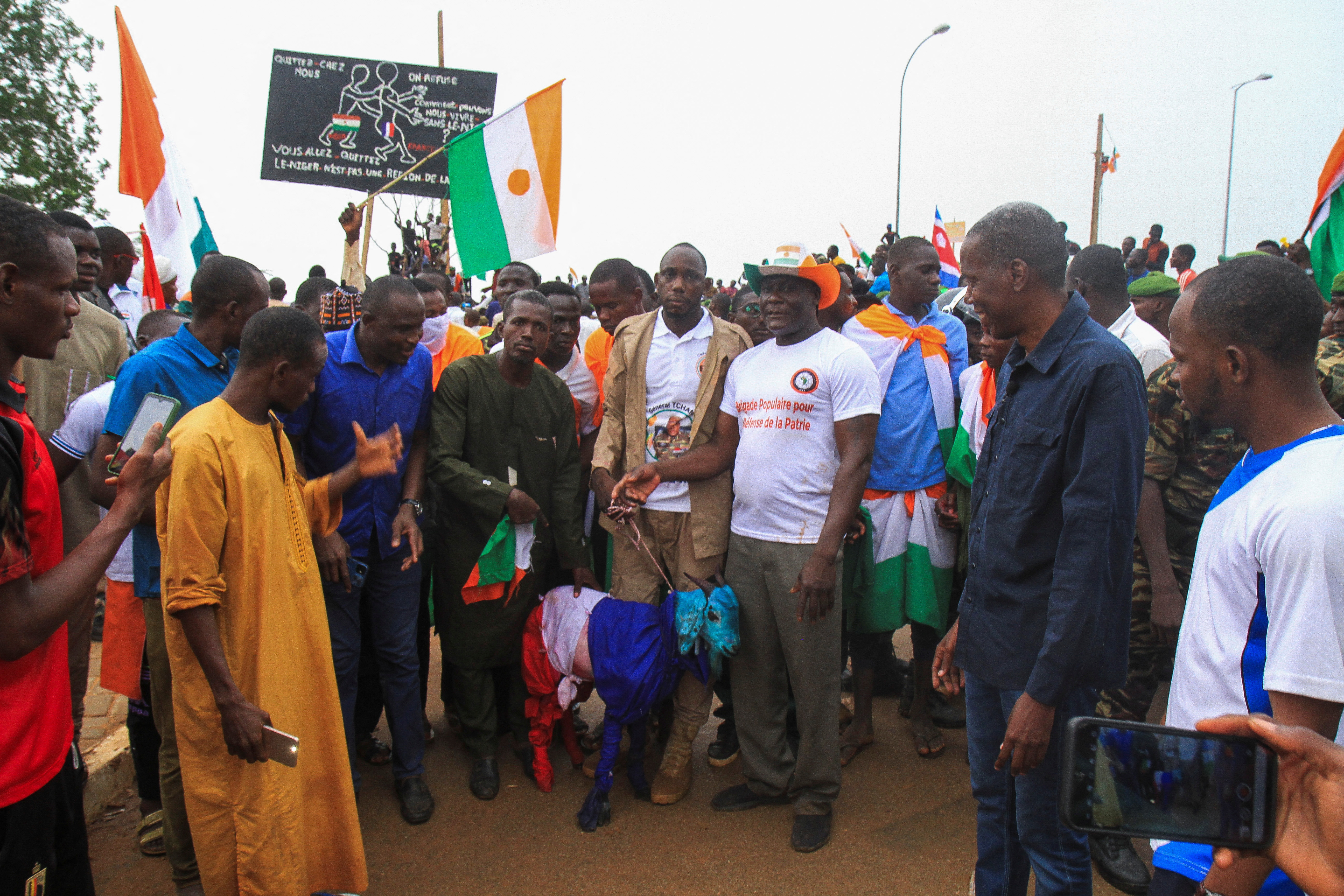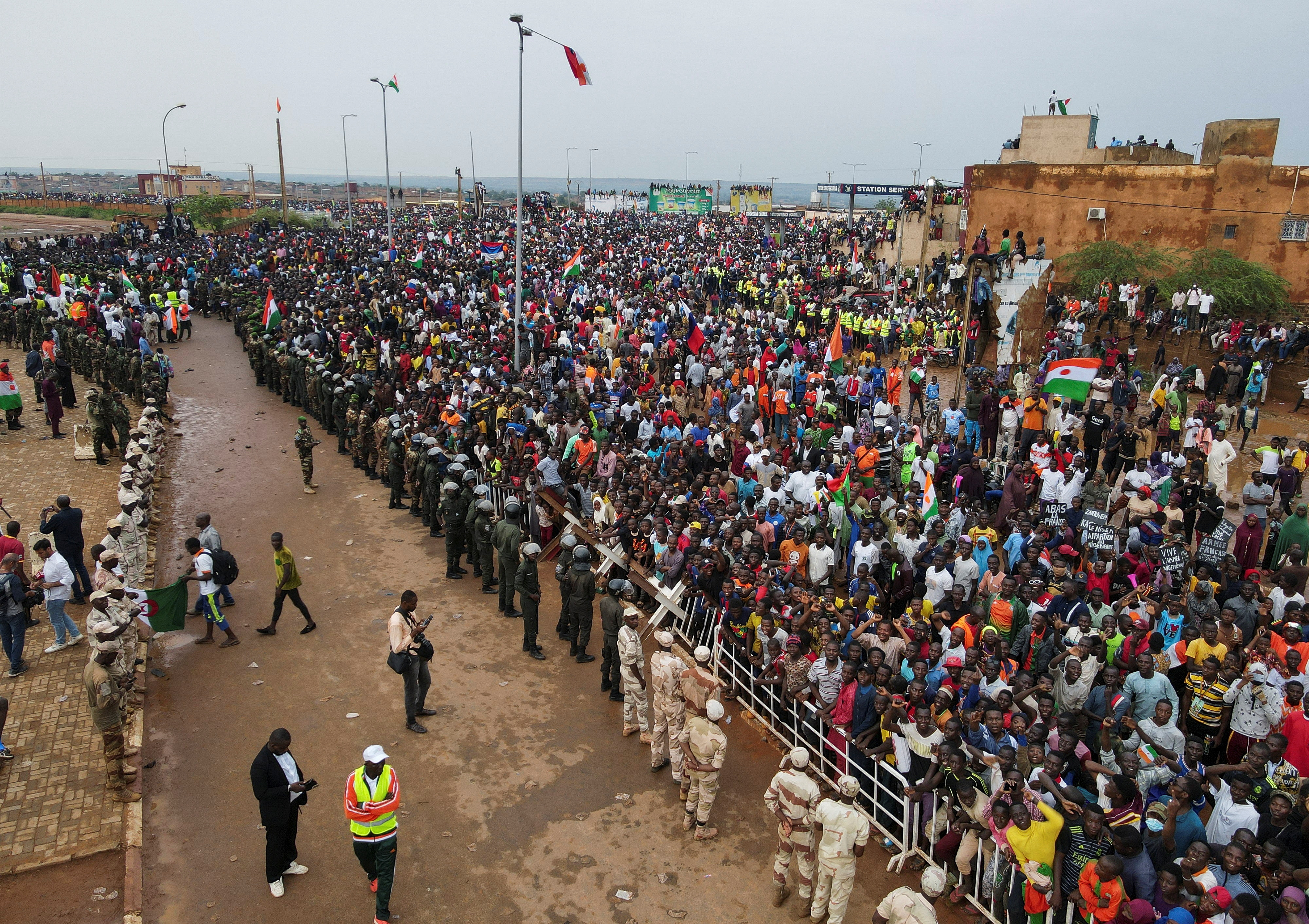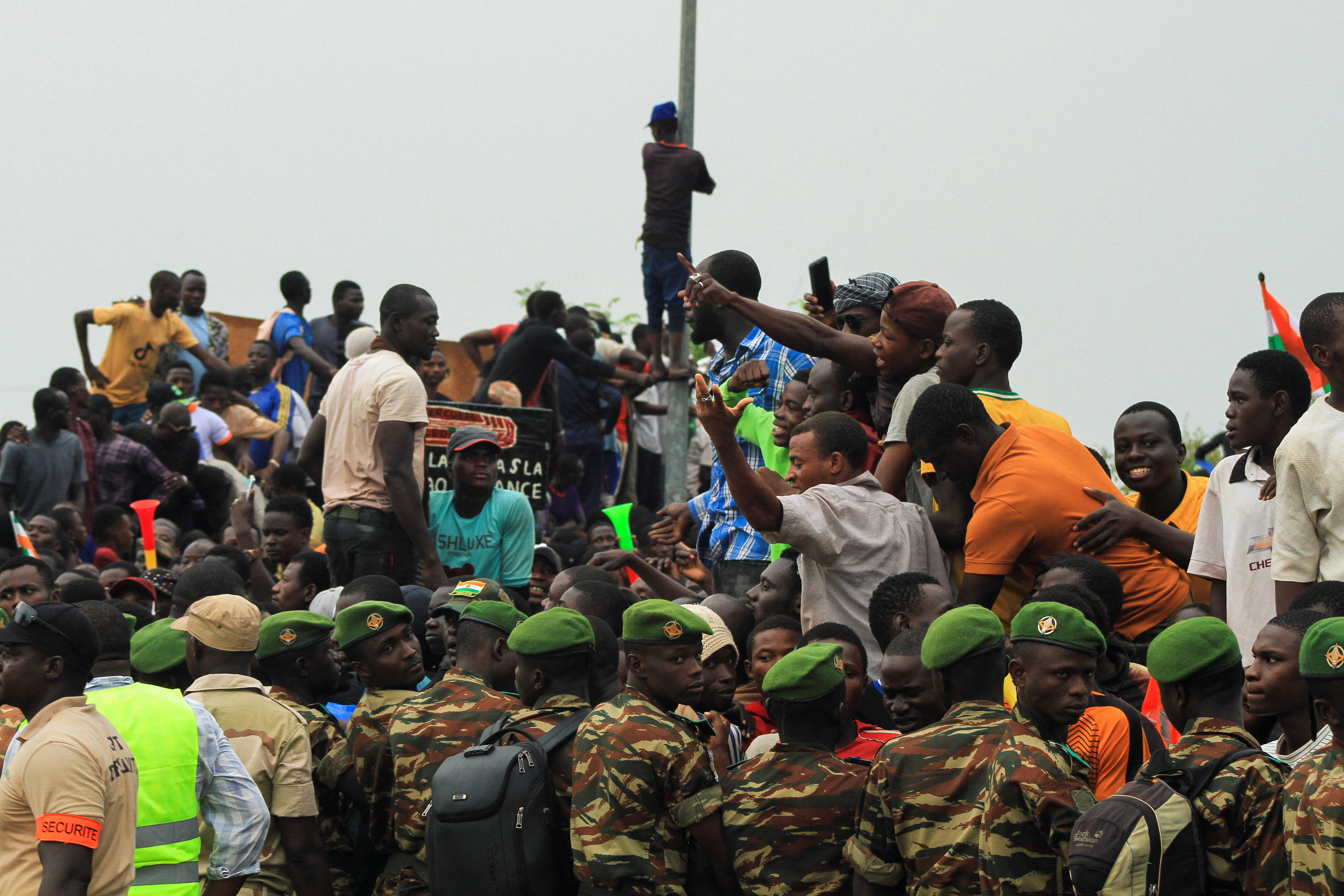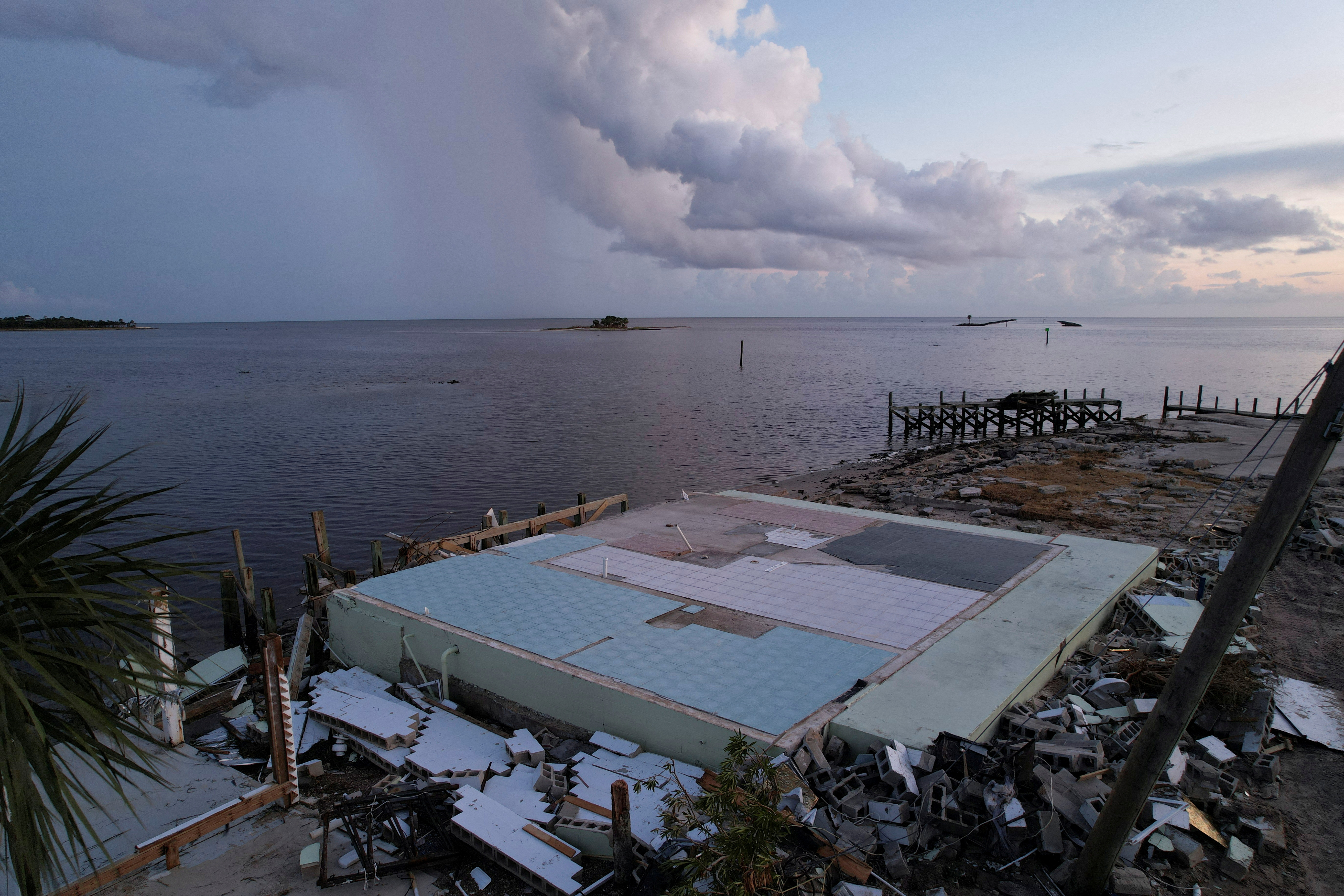The post Musk’s changes at Twitter helped spread Russian propaganda, EU … – The Washington Post first appeared on The News And Times – thenewsandtimes.com.
Day: September 2, 2023
The post On this week’s AP Religion Minute, Pope Francis travels to Mongolia to support its small Christian community, and the Vatican’s foreign policy objectives. first appeared on The News And Times – thenewsandtimes.com.
Tens of thousands of protesters gathered outside a French military base in Niger’s capital Niamey on Saturday demanding that its troops leave in the wake of a military coup that has widespread popular support but which Paris refuses to recognise.
The July 26 coup – one of eight in West and Central Africa since 2020 – has sucked in global powers concerned about a shift to military rule across the region.
Most impacted is France, whose influence over its former colonies has waned in West Africa in recent years just as popular vitriol has grown. Its forces have been kicked out of neighbouring Mali and Burkina Faso since coups in those countries, reducing its role in a region-wide fight against deadly Islamist insurgencies.
Anti-French sentiment has risen in Niger since the coup but soured further last week when France ignored the junta’s order for its ambassador, Sylvain Itte, to leave. Police have been instructed to expel him, the junta said.
Outside the military base on Saturday, protesters slit the throat of a goat dressed in French colours and carried coffins draped in French flags as a line of Nigerien soldiers looked on. Others carried signs calling for France to leave.
Reuters reporters said it was the biggest gathering yet since the coup, suggesting that support for the junta – and derision of France – was not waning.
“We are ready to sacrifice ourselves today, because we are proud,” said demonstrator Yacouba Issoufou. “They plundered our resources and we became aware. So they’re going to get out.”
By early evening local time, there had been no apparent outbreaks of violence.
France had cordial relations with ousted President Mohamed Bazoum and has about 1,500 troops stationed in Niger.
On Friday, French President Emmanuel Macron said he spoke to Bazoum every day and that “the decisions we will take, whatever they may be, will be based upon exchanges with Bazoum.”
Niger’s junta denounced the comments as divisive and served only to perpetrate France’s neo-colonial relationship.
France is not the only country with concerns. West Africa’s regional bloc ECOWAS has slapped sanctions on Niger and threatened military action as a last resort. The United States and European powers also have troops stationed in the country.
Nigeria’s President Bola Tinubu, who holds ECOWAS’ revolving chairmanship, said last week that a nine-month transition back to civilian rule could satisfy regional powers.
Niger’s junta had previously proposed a three-year timeline.
Related Galleries:





The post Huge protests in Niger call for French forces to leave after coup first appeared on The News And Times – thenewsandtimes.com.

President Bola Tinubu has ordered a recall of Nigeria’s ambassadors the world over with immediate effect, his spokesman said on Saturday.
“The president is determined to ensure that world-class efficiency and quality, will henceforth, characterize foreign and domestic service delivery to citizens, residents and prospective visitors alike,” presidential spokesman Ajuri Ngelale said.
Nigeria’s United Nations permanent representatives in New York and Geneva are exempted from the “total recall” due to the upcoming United Nations General Assembly (UNGA) later in the month, Tinubu’s office said in a statement.
Nigeria has 109 diplomatic missions worldwide, comprising 76 embassies, 22 high commissions and 11 consulates.
Tinubu, who has embarked on the country’s boldest reforms in decades, is scheduled to hold talks with U.S. President Joe Biden on the sidelines of the general assembly and also meet leaders from Brazil, India, South Korea and Germany during the G20 meeting later in the month.
The post Nigerian president recalls ambassadors worldwide first appeared on The News And Times – thenewsandtimes.com.

Help support our 2024 efforts by donating here.
A lot of President Biden’s detractors like to act as though all the money being spent now is being sent overseas to Ukraine – ignoring the fact that a lot of the weapons they need have already been produced and foreign spending generally makes up a small part of the budget.
The Inflation Reduction Act and Build Back Better both call for considerable investments in American infrastructure and the economy as well as a number of social programs, enough impact that it’s basically the closest we’ve come to a modern day incarnation of the Roosevelt administration’s New Deal.
The week of Aug 27 to Sept 2 was declared Overdose Awareness week, and on Thursday, the Biden Administration declared that more than $450 million would be spent on preventing deaths related to overdose, with $83 billion spent so far on helping people recover and get treatment, a 42% increase over the last four years.
While the former guy and Republicans are ranting about executing drug dealers and invading Mexico, the Biden administration is getting real results at home and leading the world by example at how to combat opioid abuse. The parallels between the GOP and the Democratic Party have never been clearer than they are today – and while Republicans like to bring up this issue, Democrats are the ones getting results.
Send $5 to Palmer Report:
![]()
Send $25 to Palmer Report:
![]()
Send $75 to Palmer Report:
![]()
The post Score another one for President Joe Biden appeared first on Palmer Report.
The post Score another one for President Joe Biden first appeared on The News And Times – thenewsandtimes.com.
The post VOA Newscasts first appeared on The News And Times – thenewsandtimes.com.
Military officers led by General Brice Oligui Nguema seized power Wednesday, placed Bongo under house arrest and installed Nguema as head of state, ending the Bongo family’s 56-year hold on power.
The coup — the ninth in the continent in three years — has raised concerns about a contagion of military takeovers across the region that have erased democratic progress made in the last two decades.
Coup leaders have come under international pressure to restore civilian government but said Friday night that they would not rush to hold elections.
The land, sea and air borders were opened because the junta was “concerned with preserving respect for the rule of law, good relations with our neighbors and all states of the world” and wanted to keep its “international commitments,” the army spokesman said on national television.
Bongo was elected in 2009, taking over from his late father, Omar, who came to power in 1967. Opponents say the family did little to share Gabon’s oil and mining wealth.
The takeover in Gabon follows coups in Guinea, Chad and Niger, plus two each in Mali and Burkina Faso since 2020, worrying international powers with strategic interests at stake.
The post Gabon Reopens Borders Three Days After Military Coup first appeared on The News And Times – thenewsandtimes.com.
U.S. President Joe Biden heads to Florida on Saturday to survey damage caused by Hurricane Idalia and comfort people affected by the storm, but he will not be meeting Ron DeSantis, the state’s Republican governor and a potential presidential rival.
Biden, a Democrat, told reporters on Friday he would see the governor during the trip, but DeSantis’ spokesman Jeremy Redfern said later that no meeting was planned and “the security preparations alone that would go in to setting up such a meeting would shut down ongoing recovery efforts.”
Responding to a question on Saturday on what had happened to the meeting, Biden told reporters, “I don’t know. He’s not going to be there.”
DeSantis, 44, is running for the 2024 Republican presidential nomination to oust Biden from the White House but trails former President Donald Trump in polls. Biden, 80, is running for re-election.
Biden and DeSantis have spoken regularly this week about the storm, which pummeled Florida’s Big Bend region with Category 3 winds of nearly 125 mph (200 kph). On Wednesday the president said politics had not crept in to their conversations. “I think he trusts my judgment and my desire to help,” Biden said.
The White House said Biden, who is traveling with his wife, Jill, informed DeSantis about the visit during a conversation on Thursday and the governor did not raise concerns then.
“Their visit to Florida has been planned in close coordination with FEMA as well as state and local leaders to ensure there is no impact on response operations,” White House spokesperson Emilie Simons said, referring to the Federal Emergency Management Agency.
DeSantis has been a sharp critic of Biden, and the two have clashed over COVID-19 vaccines, abortion and LGBT rights. But they met last year when Biden came to Florida to assess the devastation from Hurricane Ian, and Biden said at the time that they had worked together “hand in glove.”
DeSantis may not want to be photographed with Biden overlooking storm damage now as the Republican presidential primary race intensifies. Though he trails Trump, DeSantis leads the other Republican candidates in the race.
When Biden visited Florida after Hurricane Ian, a photo of DeSantis standing awkwardly to the side as Biden talked animatedly with a local couple went viral, highlighting the difference between the two politicians’ styles of public interaction.
Former New Jersey Governor Chris Christie, who is also running for the 2024 Republican presidential nomination, drew criticism for his praise of President Barack Obama in 2012 when the Democrat visited his state in the aftermath of superstorm Sandy.
Biden will visit Live Oak, Florida, take an aerial tour of the damage and receive a briefing about recovery efforts, the White House said. He and the first lady will also tour a community that was hit by the storm.
Biden visited Hawaii just last week in the aftermath of deadly fires there and said on Wednesday that no one could deny the climate crisis in light of the extreme weather. He is slated to travel to his home state of Delaware for the weekend after concluding the Florida trip.
Related Galleries:


The post Biden heads to Florida to survey storm damage, will not meet with DeSantis first appeared on The News And Times – thenewsandtimes.com.

Ukrainian soldiers fire a howitzer at targets in the direction of Bakhmut on the eastern front line on Monday.
As Ukraine pushes slowly forward in its counteroffensive, it’s relying heavily on the effort of hundreds of small-scale assault groups, each tasked with attacking a single trench, tree line or house.
Ukrainian soldiers fire a howitzer at targets in the direction of Bakhmut on the eastern front line on Monday.Credit…
By Marc Santora
Photographs by Tyler Hicks
- Sept. 2, 2023Updated 5:04 a.m. ET
The mission for the Ukrainian unit was to take a single house, in a village that is only a speck on the map but was serving as a stronghold for Russian soldiers.
Andriy, a veteran marine, had waited for three days with his small assault team — none of whom had seen combat before — as other Ukrainian units crawled through minefields, stormed trenches and cleared a path to the farming village of Urozhaine. Finally, one day last month, the order came to move.
They raced to a predetermined location in an armored personnel carrier, and disembarked as explosions and gunfire rattled the ground beneath their feet, Andriy and members of his unit said. Driving out or killing the remaining Russians, they secured the house as night fell, posting guards and reviewing the day’s tactics to see how they might improve.
In the morning, the new order came: Take another house.
The monthslong campaign to breach heavily fortified Russian lines is being conducted in many domains and in many forms of battle, with artillery duels and drone strikes across the breadth of the front in southern Ukraine. But the engine driving the effort are hundreds of small-scale assault groups, often just eight to 10 soldiers, each tasked with attacking a single trench, tree line or house.
In this tactical approach, small villages loom large. They line paved roads, facilitating transport, and the buildings, even those ravaged by shelling, provide a measure of cover. The Russians are using them as strongholds; Urozhaine, for instance, was ringed by two trench lines and a maze of tunnels that allowed Russian troops to shoot in one location, then pop up somewhere else.

Ukrainian marines practice house-to-house combat during training exercises in the region of Vuhledar in August.
It’s a hard way to fight a war — village by village, house by house — with no guarantee of success. Once taken and secured, however, the surviving Russian fortifications provide a base for the Ukrainians to plot their next move forward.
This has been the pattern for Ukraine as it tries to move along two north-south routes toward the Sea of Azov, looking for a place to break through and sever the so-called land bridge between Russia and occupied Crimea.
To the West, Ukrainian forces have been pushing on the path that leads toward Melitopol; having secured the key village of Robotyne, they were fighting fiercely this week at the village of Verbove, the next step in the advance. On Friday, the Ukrainian military said it had pushed three and a half miles beyond Robotyne, and John Kirby, the White House National Security Council spokesman, said Ukraine had made “notable progress” in the preceding 72 hours.
Urozhaine lies on a route farther east, along a small rural road that leads to Mariupol on the southern coast.
The battle over the village would last nine days, with the Russians finally retreating on Aug. 19 under a hail of Ukrainian artillery fire. It was a small but necessary step. As with Robotyne, securing it meant Ukraine’s forces had broken through the Russians’ first layer of defenses. Just as importantly, they have now held it for two weeks.
There are still some 60 miles of hard road ahead for the Ukrainians before they can reach the coast, and at least one more heavily fortified Russian defensive line in their way. The Russians are resisting fiercely, protected by entrenched positions, minefields and air superiority. The marines expect the fight to be bloody and slow.
“Russians have more artillery, more tanks, more drones, and more people,” said a veteran marine named Denis. “And they also fortify very well — whenever they get to somewhere — be it a settlement, a forest belt, or just a field.”
The Ukrainians allowed a team from The New York Times to visit marines fighting on the road to Mariupol on multiple occasions over two weeks in August, on the condition that the journalists not reveal precise locations, soldiers’ full names and ranks, and certain operational details.
Daily success is measured in yards rather than miles. But dozens of these assaults have been raging daily for weeks and, taken together, they are adding up to gains that Ukraine says will pose increasing problems for overstretched Russian forces.
In more than a dozen interviews in recent days, troops engaged in combat voiced great confidence that they can break the Russian lines.
“After the first and the second lines there will be the straight way toward the sea, no more fortifications,” said Maksym, another veteran marine who fought in Urozhaine. “We will move like rockets.”
The marines are fighting on a line that runs south along the T0158, a rural road that winds its way through the Mokri Yali River Valley, where Ukrainians have retaken a series of villages since launching their counteroffensive in June. The next major assault target is Staromlynivka, about 12 miles from where the campaign began.
The Russians are racing in reinforcements to try and stop the advance, Ukrainian soldiers said.
Their description of the battle at Urozhaine was supported by unedited Ukrainian drone footage viewed by The Times. Key details also corresponded with accounts posted on social media by Russian soldiers and bloggers.
Before attacking Russians in a village, Ukrainians fight to control the elevated positions on the flanks, hoping to make the Russian positions untenable and limit the house-to-house fighting.
Each settlement presents many of the same challenges, so the marines map out each assault and drill as much as they can before launching an attack.
“The most important thing is to hold the first street,” Denis said. “Then we send an additional drone that looks at each building. Our soldiers are divided into two groups: the fire group and the maneuver group. The fire group shoots Russians hiding on different floors of the building and then the maneuver group clears it. This is how we move house after house.”
If the assault fails, he said, they call in artillery strikes and destroy the house.
The Russians are also adapting, the marines said, including using new tactics to make the already treacherous minefields even more lethal.
They will lace a pasture filled with mines with a flammable agent, for instance. Once the Ukrainians get to work clearing an opening, the Russians will drop a grenade from a drone, igniting a sea of fire and explosions.
The mining makes control over paved roads essential; they are the safest routes because mines are easier to spot and remove. The Russians know this and have set up defenses along the T0158, with concrete bunkers for machine gunners. Russian drones keep the roads under constant surveillance.
As Denis spoke a few miles from the line of contact, a unit was practicing an assault on a house. There is no shortage of battered buildings to run such drills, so they move locations often.
But Russian drones picked up the gathering of soldiers and fired rockets at them. The soldiers heard the whistle of the incoming rockets and had seconds to dive for cover. They scattered as the Russians unleashed another salvo. A hail of rockets crashed around the marines, but no one was injured.
A few days later, another group was preparing for their next assault along the road to Mariupol. They were among a recent influx of Marines who had completed training in Britain but had yet to experience combat.
A trainer named Vasyl, 53, was running the drills, barking orders as the new soldiers fired live rounds and rocket-propelled grenades for the first time. Time is a luxury they do not have as battles rage, he said, “so we do our best to get them ready as soon as possible.”
A key part of forming a successful assault unit, the soldiers said, was finding the most motivated recruits willing to race into a cauldron of destruction.
Like other Ukrainian outfits, the marines are composed of a mix of career fighters, volunteers and mobilized conscripts. About 70 percent come from the local area — including the occupied city of Mariupol — and soldiers believe that gives them a distinct advantage over an enemy they view as fighting for a paycheck, and holding positions out of fear of punishment for retreating.
As experienced soldiers, Andriy and Maksym, both 35, guided the new recruits.
“Of course we had some losses, not within our platoon, but within the brigade,” Maksym said. “It’s war, you know.”
Still, the marines achieved their objective in Urozhaine and were one small step closer to the sea.
“It’s also important for self-confidence and motivation,” Maksym said. “Many of the guys were new, it was their first fight. And now they know how it is.”
Gaëlle Girbes and Dimitry Yatsenko contributed reporting from the front line.
Marc Santora has been reporting from Ukraine since the beginning of the war with Russia. He was previously based in London as an international news editor focused on breaking news events and earlier the bureau chief for East and Central Europe, based in Warsaw. He has also reported extensively from Iraq and Africa. More about Marc Santora
Tyler Hicks is a senior photographer for The Times. In 2014, he won the Pulitzer Prize for Breaking News Photography for his coverage of the Westgate Mall massacre in Nairobi, Kenya. More about Tyler Hicks
The post A Brutal Path Forward, Village by Village first appeared on The News And Times – thenewsandtimes.com.


